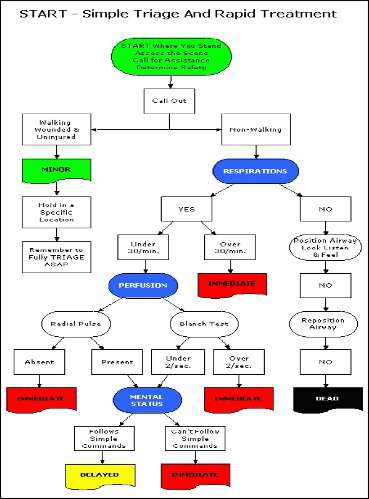Last night, I attended my second class of C.E.R.T. training (Community Emergency Response Team). It was fun and I learned quite a bit. In last night's class, we covered the following items:
How to Assess a Situation
When arriving at the scene of an emergent event, one of the easiest ways to avoid injury and “becoming part of the problem” is to perform a rapid visual assessment of the environment. The point here is to never enter into an unsafe environment. It may be necessary, for example, to visually assess the situation from inside your vehicle. The best help that you can offer in such a situation is to secure your own safety first, and then report as much information as possible to professional emergency responders. Their job will be to secure the area, determine appropriate response/entry, evacuate the area, search/rescue/treat victims, and prevent injury to service personnel.
In an ideal situation, another trained individual would accompany you to the scene where you can determine the appropriate response.
The Priority of Personal Safety
Personal, Partner, and Patient safety cannot be overemphasized. This is why firefighters and police officers are instructed to make entry into a threatening situation only when estimated risk is manageable AND they have the appropriate personnel support such endeavors. Two common sayings you will hear in regards is, “Don't become part of the problem”, or “We don't need another victim”.
The Importance of Incident Documentation
As with medical procedures performed in controlled settings, appropriate responses to emergent scenes require the documentation of facts, actions taken, and observed responses. A professional paramedic friend of mine said it simply, “If you didn't write it down, then it didn't happen.” The documentation of the number of victims, observable threats, actions taken, and the progressive events helps to relay the gravity of the situation to other responders and for future study, post-event. Debriefings are post-event meetings that allow responders to discuss the event and to begin analyzing it in hopes of learning from it for future events. In this way, more appropriate responses can be created and practiced. Documentation also lends itself to legal review in cases where responders are required to testify about their actions on-scene.
Intro to MCI (Mass Casualty Incidents)
This portion of the training is designed to provide responders with time-sensitive responses to incidents involving several victims. Psychologically, the algorithmic flow of responder actions appears insensitive and heartless, allowing victims only brief attention from the responder until he/she categorizes the victim and then moves on to the next victim. During this section of training, the harsh reality of “doing the greatest good for the greatest number [of people]” struck me. This truly was an eye-opener for me personally!
This word comes from the French infinitive “trier”, meaning “to sort”. To perform a triage, responders establish priority of medical attention to affected victims & “tag” them accordingly. Fundamentally, the triage operates with the understanding that in an MCI, appropriate resources and personnel will be limited from helping each victim with the same urgency and quality of care as others.
RPM- Respiratory, Perfusion, Mental status
Once a responder has begun to perform assessments on victims of an MCI, they first determine if the victim is breathing on their own. If not, the responder can attempt to reposition the airway in hopes of facilitating spontaneous breathing. If no respirations are present, then the responder will attempt one more re-positioning. If the second attempt to open the airway is unsuccessful in obtaining respirations, then the victim is tagged with a black morgue tab from the triage card.
There are several other possible outcomes to initiating a START. The example of the morgue tag is the worst-case scenario flow of running the algorithm. For other possible outcomes and more info, read THIS (downloadable PDF).
Several more points were discussed in last night's class including:
- Permission to assist on conscious vs. implied consent on unconscious
- Rolling unconscious victim over (log roll)
- Checking for breathing (open airway)
- Different Types of Bleeds (Arterial vs. Venous)
- Controlling bleeding (non life-threatening wound)—covered bleeding a lot
- Basic Wound Dressing
- The Reality of Tourniquets
- Pool Water a No-No: balance of the water, commercial chemicals used, plaster, metal, etc.
- Burns (1st, 2nd, 3rd degrees)
- Heat Loss Prevention from Hypothermia
I will detail the bullet points above in a follow-up post…but now, back to studying the material for the next class!
-The Berkey Guy








No comments yet.